Abstract
This study describes the use of electrical impedance Z to continuously measure the stroke volume SV of a skeletal muscle-powered ventricle (SMV). An SMV was constructed surgically in four anaesthetised dogs. The rectus abdominis (two dogs) or latissimus dorsi (two dogs) muscle was wrapped around a compressible pouch, the ends of which were connected to a saline-filled (0·9 per cent) mock circulation. The motor nerves to the muscle were stimulated to produce tetanic contractions at a rate of 10 min−1. Z was measured between brass sleeve electrodes within the end conduits of the pouch. To derive a simple expression relating pouch volume V to Z, the pouch was represented as two truncated cones with their bases joined. For V ranging from 53 to 103 ml, the relationship between Z and\(1/\sqrt V \) was nearly linear; i.e.\(Z = m(1/\sqrt V ) + b\). Impedance-derived stroke volume SV (ΔZ) was calculated using this linear approximation and the impedance measured just before and after muscle contraction. The stroke volume SV (EM) ejected by the pouch during muscle contraction was measured with an electromagnetic flowmeter. The linear regression coefficients ranged from 0·99 to 2·55; the correlation coefficients ranged from 0·90 to 0·98. In general, SV(ΔZ) tracked SV(EM) very well, although SV(ΔZ) tended to overestimate SV(EM).
Similar content being viewed by others
References
Badylak, S. F., Stevens, L., Janas, W., Gray, M. H., Geddes, L. A. andVoorhees, W. D. III (1989). Cardiac assistance with electrically stimulated skeletal muscle.Med. & Biol. Eng. Comput.,27, 159–162.
Geddes, L. A. andBaker, L. E. (1989).Principles of applied biomedical instrumentation, 3rd edn. John Wiley & Sons, Inc., New York, NY, Chap. 11.
Geddes, L. A., Wessale, J. L., Badylak, S. F., Janas, W., Tacker, W. A. andVoorhees, W. D. (1990) The use of an electrically activated valve to control preload and provide maximal muscle blood flow with a skeletal-muscle ventricle.Pace,13, 783–795.
Mannion, J. D., Hammond, R. andStephenson, L. W. (1986). Hydraulic pouches of canine latissimus dorsi.J. Thorac. Cardiovasc. Surg.,91, 534–544.
Spotnitz, H. M., Merker, C. andMalm, J. R. (1974) Applied physiology of the canine rectus abdominis: force-length curves correlated with functional characteristics of a rectus powered ‘ventricle’. Potential for cardiac assistance.Trans. Am. Soc. Artif. Int. Organs,20, 747–756.
Stevens, L., Badylak, S. F., Janas, W., Gray, M., Geddes, L. A. andVoorhees, W. D. III (1989) A skeletal muscle ventricle made from rectus abdominis muscle in the dog.J. Surg. Res.,46, 84–89.
Walsh, G. andChiu, R. C. (1986) Skeletal muscle for cardiac repair and assist: a historical overview. InBiomechanical cardiac assist: cardiomyoplasty and muscle-powered devices.Chiu, R. C. (Ed.), Futura Publishing Co. Inc., Mt Kisco, New York, 1–18.
Author information
Authors and Affiliations
Rights and permissions
About this article
Cite this article
Wessale, J.L., Geddes, L.A., Badylak, S.F. et al. Use of electrical impedance for continuous measurement of stroke volume of a skeletal muscle-powered cardiac assist device. Med. Biol. Eng. Comput. 29, 207–211 (1991). https://doi.org/10.1007/BF02447109
Received:
Accepted:
Issue Date:
DOI: https://doi.org/10.1007/BF02447109




